Novel Transformer Fault Identification Optimization Method Based on Mathematical Statistics
Abstract
:1. Introduction
2. Transformer Vibration Signal Characteristics
2.1. Characterization of Transformer Vibration Signals
2.2. Measurement of the Transformer Vibration Signal
2.3. Transformer Vibration Signal Energy Spectrum Analysis
3. Optimization Method for Transformer Fault Identification
3.1. Distribution Characteristics of Transformer Vibration Signals
3.2. Basic Theory of Mathematical Statistics Methods
3.3. Feasibility Analysis of Simplifying Noise Reduction
3.4. Feasibility Analysis of the Mathematical Statistics Methods
4. Mathematical Statistics Method Application Examples
Mathematical Statistics Method Application Examples
5. Summary
- When the mathematical statistics method is used to analyze the vibration signal of the transformer, the noise exerts little influence on the accuracy of transformer fault identification. Simplification of the noise reduction of the signal reduces noise reduction costs and the fault identification time.
- The vibration signal of the transformer is analyzed by a mathematical statistics method and the cumulative probability distribution curve of the vibration signal is illustrated. Then, the least-squares fitting line of the cumulative probability distribution function of the vibration signal is solved by the least-squares method. According to the wavelet transform of different scales, the proportion of the high-frequency component to the low-frequency energy is obtained by combining wavelet theory to quantify the frequency band energy of the vibration signal. Thus, the energy threshold of each frequency band of the transformer vibration signal with different fault degrees can be calculated, and the cumulative probability distribution corresponding to the vibration signal of the transformer with different fault degrees can be fitted to the straight line. The slope threshold can then be determined.
- Transformer winding produces a short-circuit fault can be determined by comparing the slope of the cumulative probability distribution of the vibration signal with the fault threshold of the FSL. Therefore, the purpose of power transformer fault identification can be achieved and the feasibility of the mathematical statistics method can be verified. The mathematical statistics method can quickly determine the fault state of power transformers, reduce the safety hazards of transformers, and improve the safety and reliability of grid operation. This method also optimizes transformer fault identification to a certain extent and provides a new idea for the development of transformer fault identification techniques.
- Since the short-time Fourier transform is more applicable to transformer vibration signal processing than the Fourier transform and the empirical modal decomposition algorithm, we used short-time Fourier transform to analyze the transformer vibration signal and, compared with the mathematical statistics methods proposed in this paper, it can be seen that the short-time Fourier transform can identify moderate and severe short-circuit faults of transformer winding, but the early mild faults of the transformer winding cannot be accurately identified, which is due to the time and frequency resolution of the window function cannot be determined by the optimal limitation at the same time in short-time Fourier transform. In comparison, the mathematical statistics method proposed in this paper is more accurate in identifying the short-circuit fault degree of the transformer winding.
Author Contributions
Funding
Conflicts of Interest
References
- Xu, C.; Wang, F.; Huang, H.; Jin, Z. Information modeling and implementation of vibration on-line monitoring of power transformer based on IEC 61850. Autom. Electr. Power Syst. 2014, 4, 60–64. [Google Scholar]
- Berler, Z.; Golubev, A.; Rusov, V.; Tsvetkov, V.; Patterson, C. Vibro-acoustic method of transformer clamping pressure monitoring. In Proceedings of the IEEE Conference Record of the IEEE International Symposium on Electrical Insulation, Anaheim, CA, USA, 5 April 2000. [Google Scholar]
- Bartoletti, C.; Desiderio, M.; Dicarlo, D.; Carlo, D.; Fazio, G.; Muzi, F.; Sacerdoti, G.; Salvatori, F. Vibro-Acoustic Techniques to Diagnose Power Transformers. IEEE Trans. Power Deliv. 2004, 19, 221–229. [Google Scholar] [CrossRef]
- Garcia, B.; Burgos, J.C.; Alonso, A.M. Transformer tank vibration modeling as a method of detecting winding deformations-part I: Experimental verification. IEEE Trans. Power Deliv. 2005, 21, 157–163. [Google Scholar] [CrossRef]
- Garcia, B.; Burgos, J.C.; Alonso, A.M. Transformer tank vibration modeling as a method of detecting winding deformations-part II: Experimental verification. IEEE Trans. Power Deliv. 2005, 21, 164–169. [Google Scholar] [CrossRef]
- He, P.; Wen, X. Survey of Frequency Response Analysis on Winding Deformation of Transformers. High Volt. Eng. 2006, 32, 37–41. [Google Scholar]
- Hong, K.; Huang, H.; Zhou, J. Winding Condition Assessment of Power Transformers Based on Vibration Correlation. IEEE Trans. Power Deliv. 2015, 30, 1735–1742. [Google Scholar] [CrossRef]
- Qian, G.Q.; Lu, Y.; Wang, F.H.; He, M.Z. Vibration response analysis of transformer winding by finite element method. In Proceedings of the 2016 IEEE Transmission and Distribution Conference and Exposition, Dallas, TX, USA, 2–5 May 2016. [Google Scholar]
- Li, X.; Huang, X.; Zhou, Z.; Zhao, Y.; Chen, Y.; Song, Y. Analysis of the measuring points selection of power transformer winding deformation though vibration test. In Proceedings of the 2016 IEEE China International Conference on Electricity Distribution, Xi’an, China, 10–12 August 2016. [Google Scholar]
- Yang, W.; Dong, H.; Yu, F.; Zhang, S.; Li, D.; Liu, X. On-line monitoring system for transformer vibration based on vibration method. Transducer Microsc. Syst. Technol. 2016, 35, 88–94. [Google Scholar]
- Sheng-Chang, J.; Yang, M.; Yu-Wen, L. Study on the oil tank surface vibration characteristics for the running power transformer. Adv. Technol. Electr. Eng. Energy 2007, 26, 24–28. [Google Scholar]
- Yang, S.; Jiao, W.; Wu, Z. Independent component analysis based networks for fault features extraction and classification of rotating machines. Chin. J. Mech. Eng. 2004, 40, 45–49. [Google Scholar] [CrossRef]
- Xu, J.; Jin, Z.; Fu, J.; Shao, Y.; Wang, F.; Jaing, Y. Detection of Transformer Winding Deformation Under Short-circuit Impulse Based on Improved Wavelet Packet Algorithm. East China Electr. Power 2010, 38, 376–380. [Google Scholar]
- Guo, J.; Ji, S.; Shen, Q.; Zhu, L.; Ou, X.; Du, L. Blind Source Separation Technology for the Detection of Transformer Fault Based on Vibration Method. Trans. China Electrotech. Soc. 2012, 27, 68–78. [Google Scholar]
- Ma, H.; Geng, Z.; Chen, K.; Wang, C.; Li, K.; Li, Y. A New Method for Fault Diagnosis of Power Transformer Winding Deformation Based on Vibration. Autom. Electr. Power Syst. 2013, 37, 89–94. [Google Scholar]
- Jahromi, A.; Piercy, R.; Cress, S.; Service, J.; Wang, F. An approach to power transformer asset management using health index. IEEE Electr. Insul. Mag. 2009, 25, 20–34. [Google Scholar] [CrossRef]
- Dehghani, A.; Ma, H.; Saha, T.K.; Ekanayake, C. Application of fuzzy support vector machine for determining the health index of the insulation system of in-service power transformers. IEEE Trans. Dielectr. Electr. Insul. 2013, 20, 965–973. [Google Scholar]
- Ahmed, A.-E.; Salama, M.M.A.; Ibrahim, M. Calculation of a health index for oil-immersed transformers rated under 69 kV using fuzzy logic. IEEE Trans. Power Deliv. 2012, 27, 2029–2036. [Google Scholar]
- Abdolrahman, P.; Weddella, S.J.; Jalal, T.; CraigLapthorna, A. Evolutionary multi-objective fault diagnosis of power transformers. Swarm Evolut. Comput. 2017, 36, 62–75. [Google Scholar]
- Ghoneim, S.S.M.; Taha, I.B.M.; Elkalashy, N.I. Integrated ANN-based proactive fault diagnostic scheme for power transformers using dissolved gas analysis. IEEE Trans. Dielectr. Electr. Insul. 2016, 23, 1838–1845. [Google Scholar] [CrossRef]
- Ma, H.; Saha, T.K.; Ekanayake, C.; Martin, D. Smart transformer for smart grid—intelligent framework and techniques for power transformer asset management. IEEE Trans. Smart Grid 2015, 6, 1026–1034. [Google Scholar] [CrossRef]
- Shengchang, J.; Yongfen, L.; Yanming, L. Research on extraction technique of transformer core fundamental frequency vibration based on OLCM. IEEE Trans. Power Deliv. 2006, 21, 1981–1988. [Google Scholar] [CrossRef]
- Murthy, P.K.; Amarnath, J.; Singh, B.P.; Kamakshaiah, S.A.N.N. Based Internal Fault Diagnosis of HVDC Converter Transformer. Int. J. Appl. Eng. Res. 2009, 4, 867–877. [Google Scholar]
- Chun-Ning, W.; Ying, Z.; Kai, C.; Hong-zhong, M. Analysis on High and Low Frequency Energy Distribution of Transformer Winding Short-circuit Fault Vibration Signal. Proc. CSU-EPSA 2013, 25, 77–82. [Google Scholar]
- Dai, W.; Liu, B. Monitoring the destortion of transformer winding using frequency response method. High Volt. Appar. 2004, 40, 464–465. [Google Scholar]
- Bandler, J.W.; Biernacki, R.M.; Cai, Q.; Shen, S.H. A novel approach to statistical modeling using cumulative probability distribution fitting. In Proceedings of the IEEE MTT-S International Microwave Symposium Digest, San Diego, CA, USA, 23–27 May 1994; Volume 1, pp. 385–388. [Google Scholar]
- Choudhury, K.; Matin, M.A. Extended skew generalized normal distribution. Metron 2011, 69, 265–278. [Google Scholar] [CrossRef]
- Teyabeen, A.A. Statistical analysis of wind speed data. In Proceedings of the 2015 IEEE Renewable Energy Congress, Sousse, Tunisia, 24–26 March 2015. [Google Scholar]
- Peng, Z.K.; Tse, P.W.; Chu, F.L. An improved Hilbert–Huang transform and its application in vibration signal analysis. J. Sound Vib. 2005, 286, 187–205. [Google Scholar] [CrossRef]
- Wu, Z. Ensemble empirical mode decomposition: A noise assisted data analysis method. Adv. Adapt. Data Anal. 2009, 1, 1–41. [Google Scholar] [CrossRef]
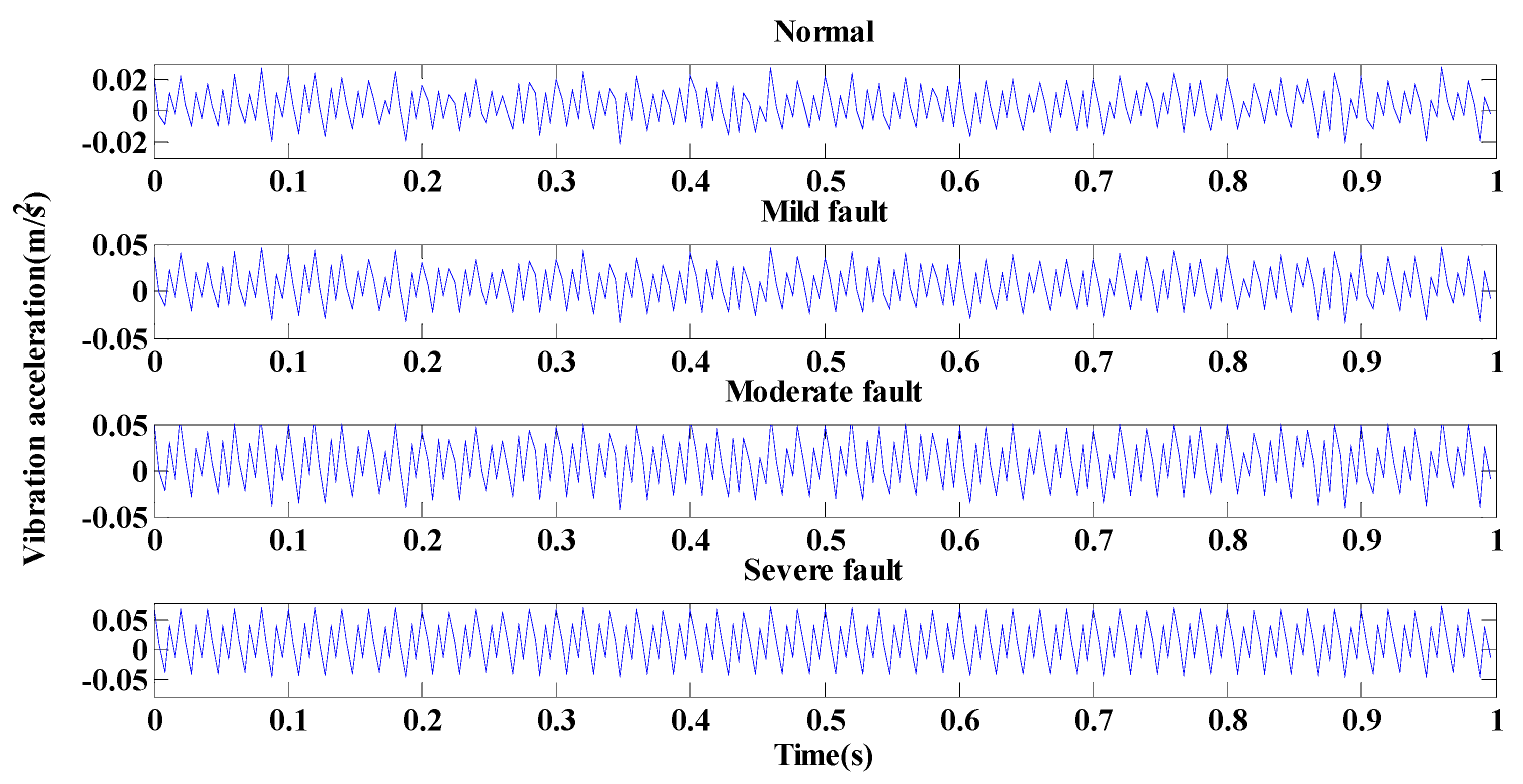
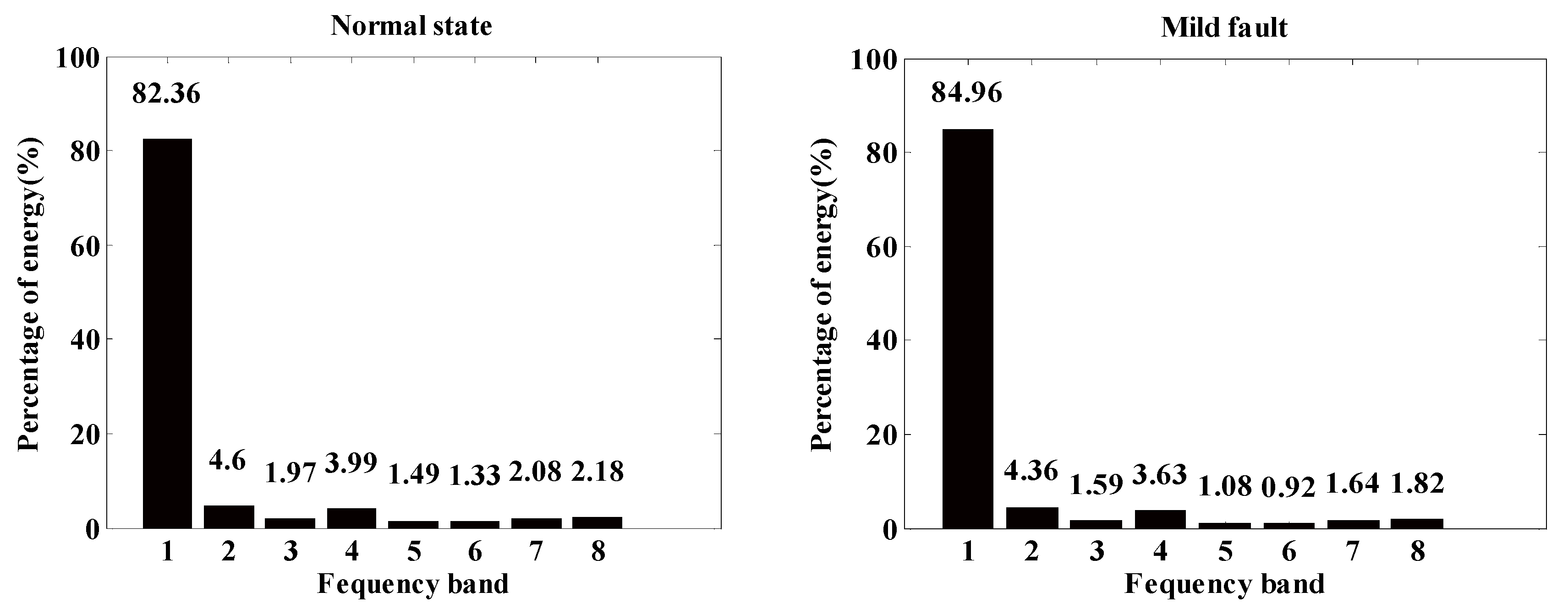
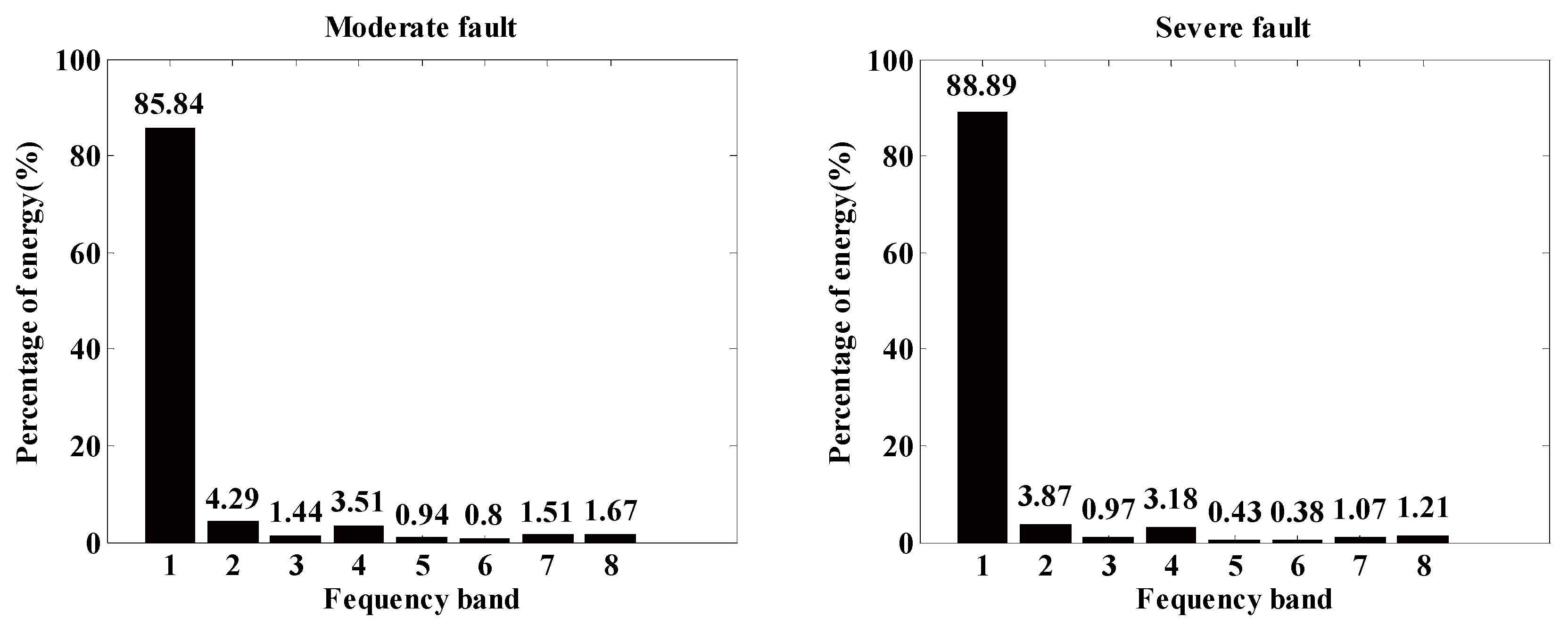
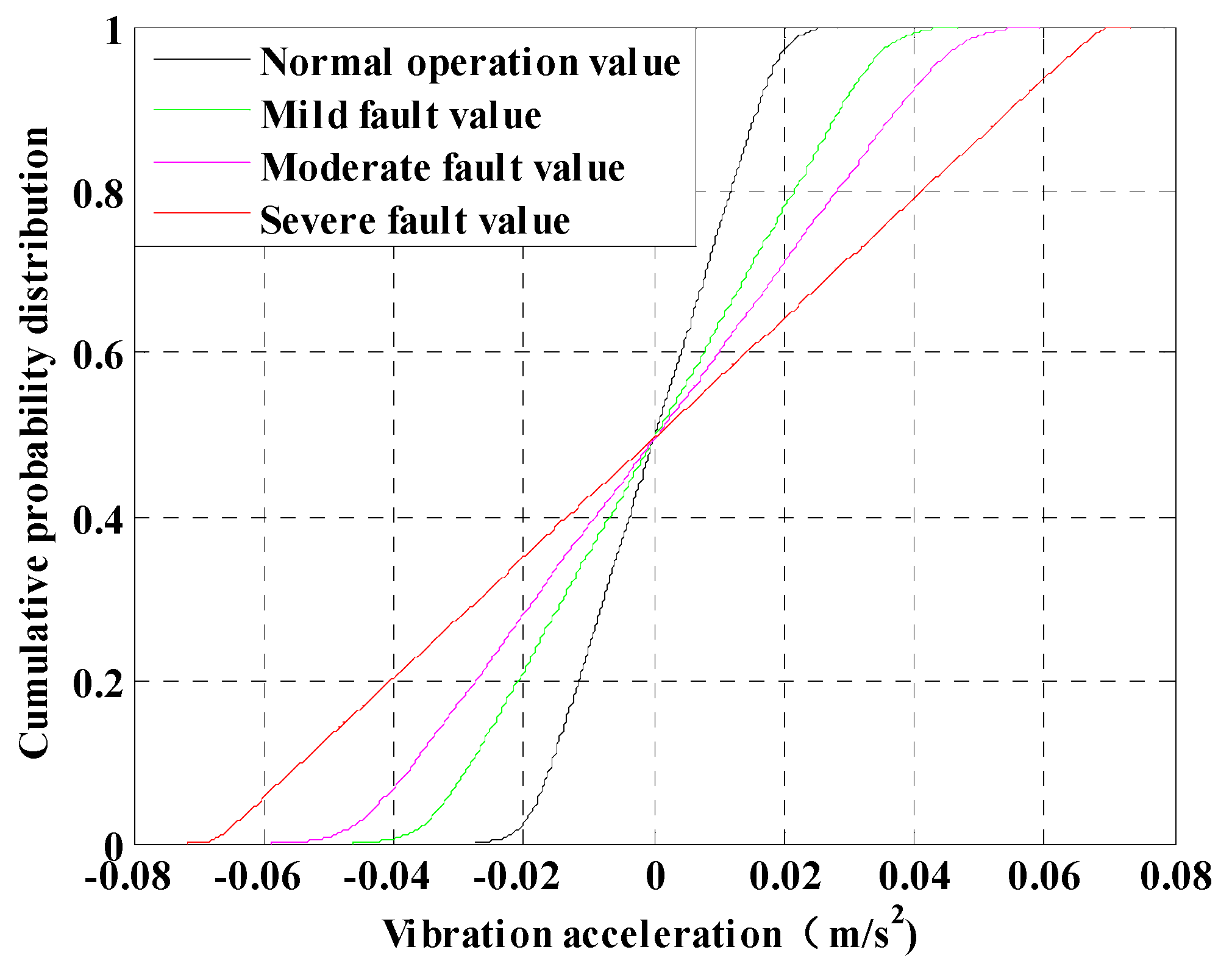
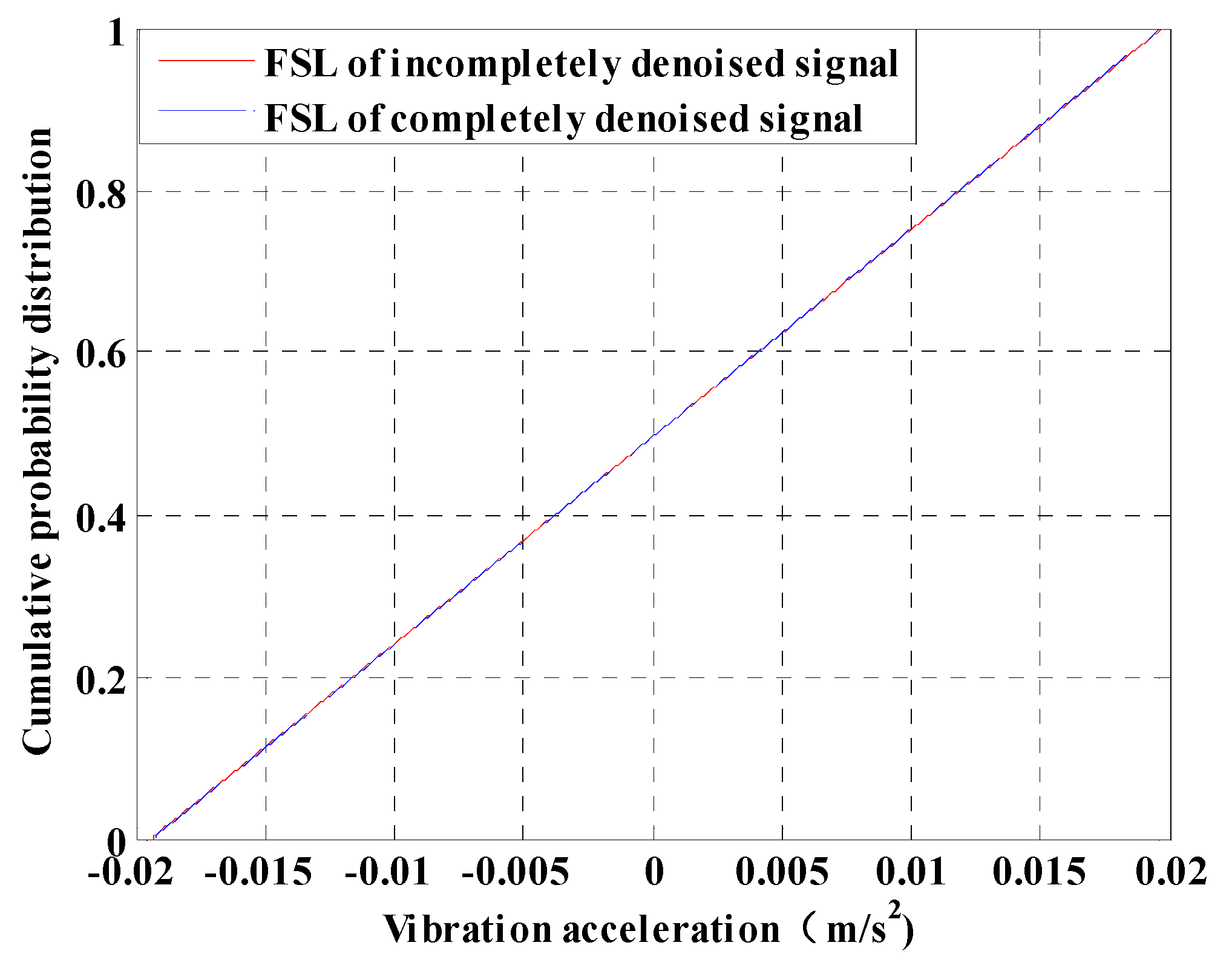
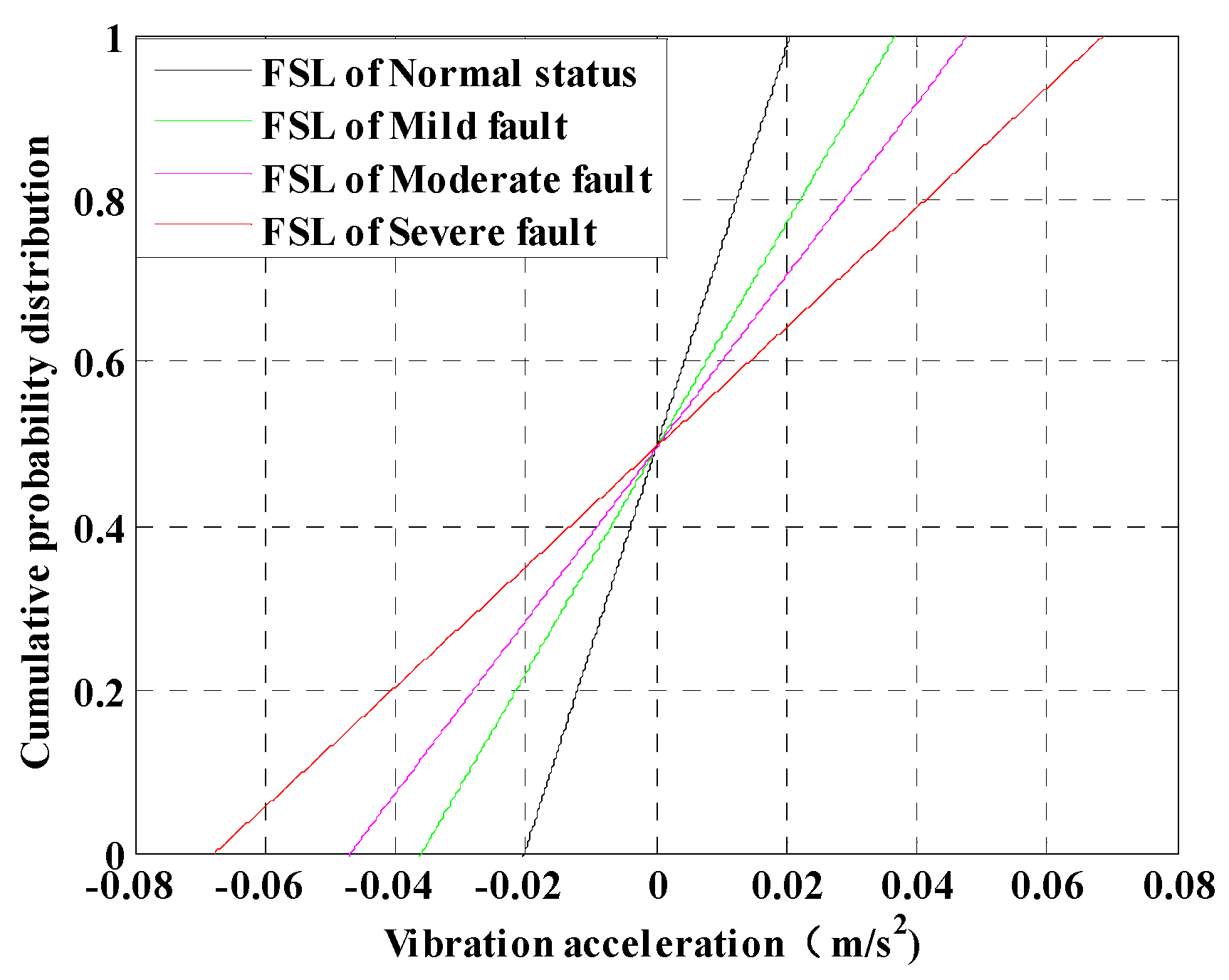
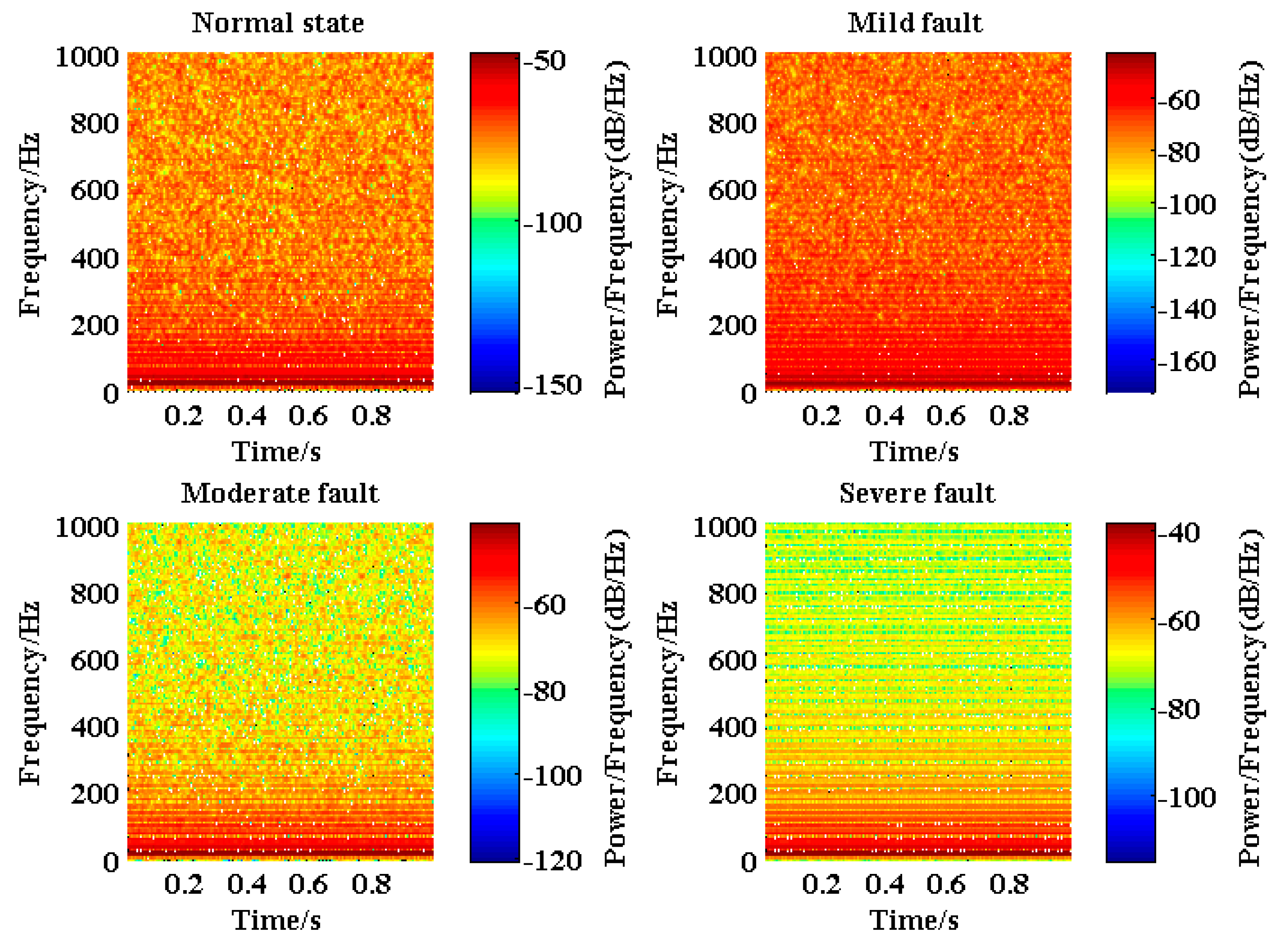

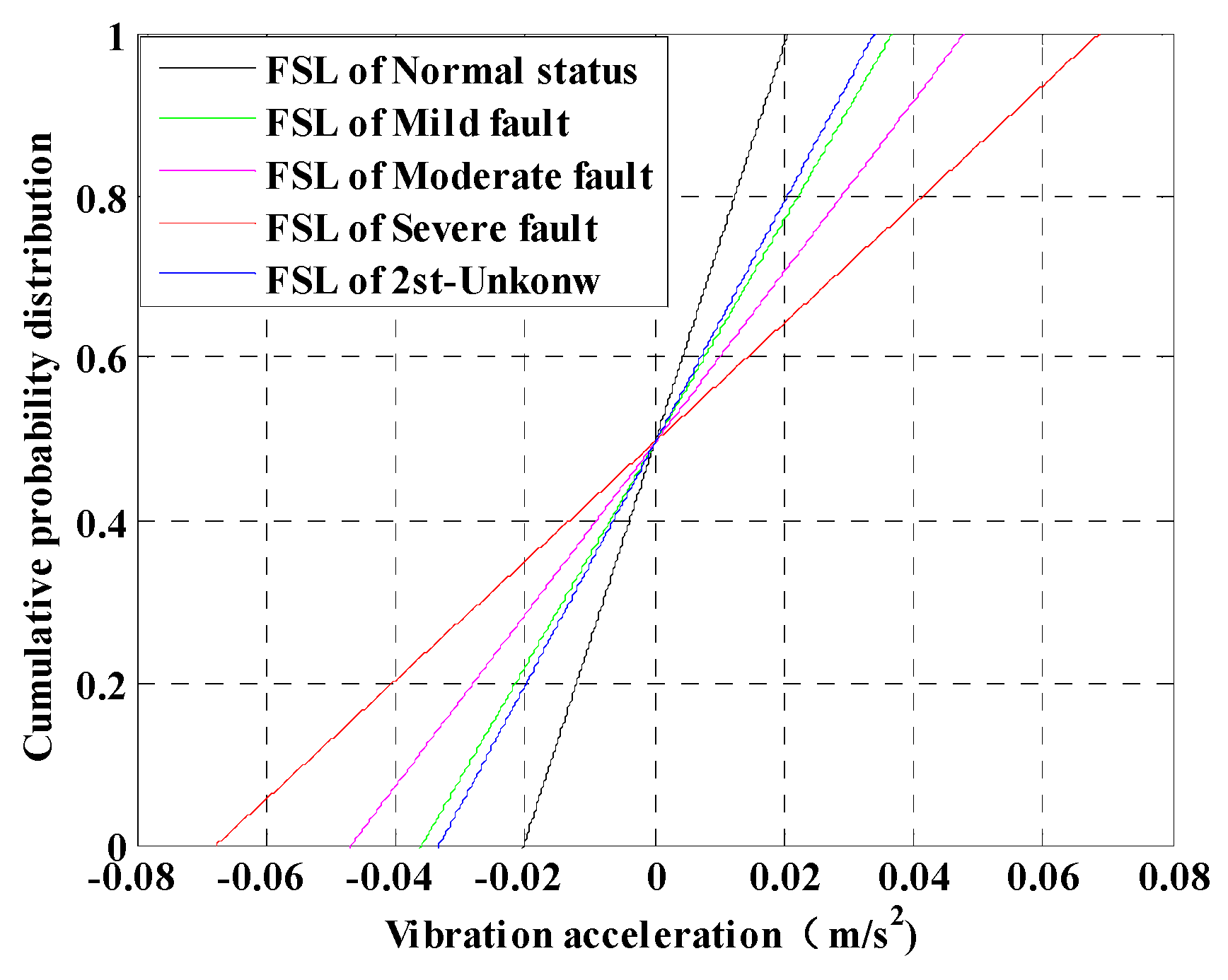

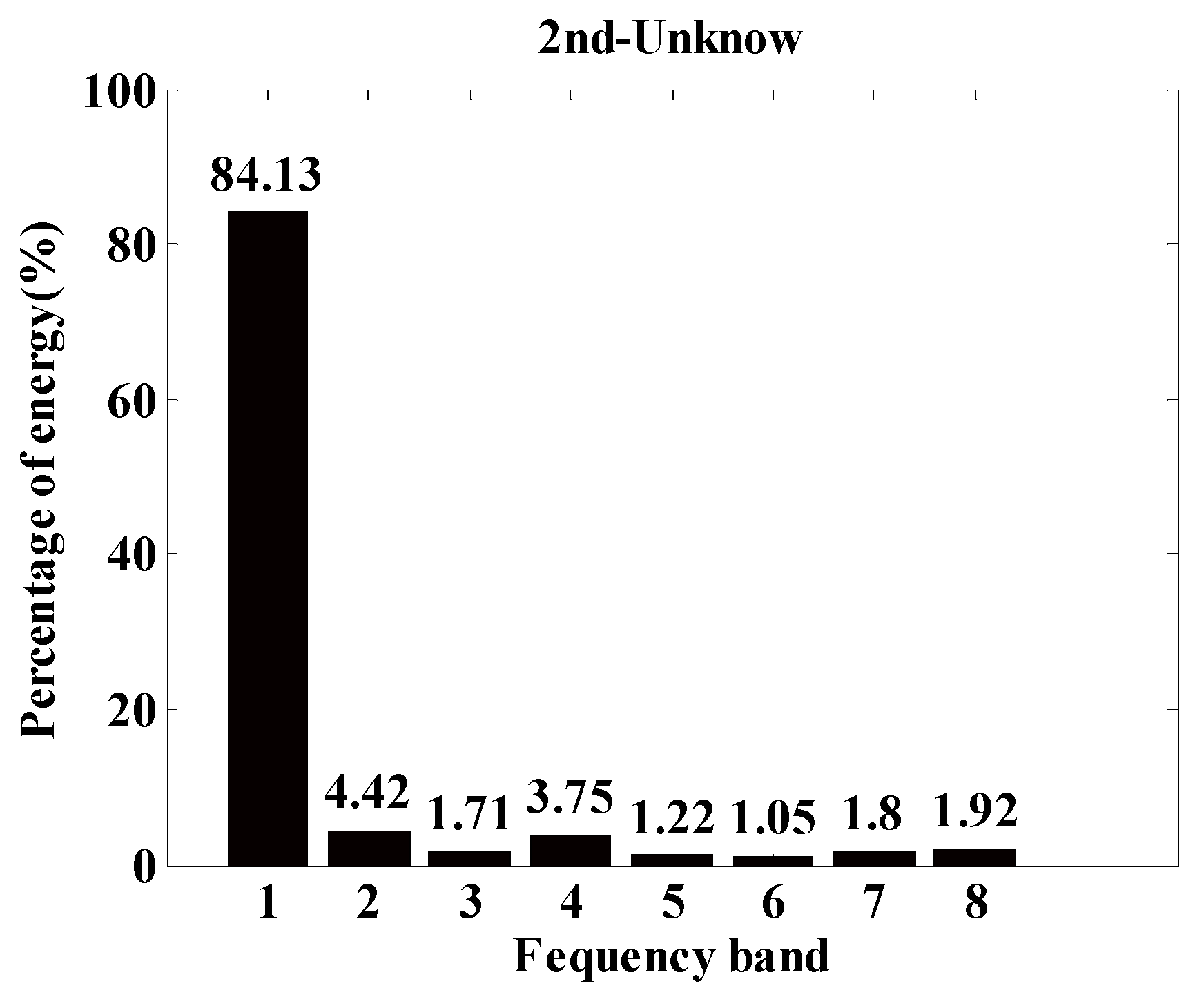
| Transformer Status | 1st FBE Ratio (%) | 2nd FBE Ratio (%) | 3rd FBE Ratio (%) | 4th FBE Ratio (%) | 5th FBE Ratio (%) | 6th FBE Ratio (%) | 7th FBE Ratio (%) | 8th FBE Ratio (%) |
|---|---|---|---|---|---|---|---|---|
| Normal status | 82.36 | 4.60 | 1.97 | 3.99 | 1.49 | 1.33 | 2.08 | 2.18 |
| Mild fault | 84.96 | 4.36 | 1.59 | 3.63 | 1.08 | 0.92 | 1.64 | 1.82 |
| Moderate fault | 85.84 | 4.29 | 1.44 | 3.51 | 0.94 | 0.80 | 1.51 | 1.67 |
| Severe fault | 88.89 | 3.87 | 0.97 | 3.18 | 0.43 | 0.38 | 1.07 | 1.21 |
| Denoising Condition | Base Frequency Energy Ratio (%) | Fitting Straight line (FSL) Slope |
|---|---|---|
| Incomplete denoising signal | 87.14 | 24.7081 |
| Complete denoising signal | 82.36 | 24.5230 |
| Transformer Status | Base Frequency Energy Ratio (%) | FSL Slope |
|---|---|---|
| Normal status | 82.36~84.96 | 13.7605~24.5230 |
| Mild fault | 84.96~85.84 | 10.5501~13.7605 |
| Moderate fault | 85.84~88.89 | 7.3297~10.5501 |
| Severe fault | ≥88.89 | ≤7.3297 |
© 2019 by the authors. Licensee MDPI, Basel, Switzerland. This article is an open access article distributed under the terms and conditions of the Creative Commons Attribution (CC BY) license (http://creativecommons.org/licenses/by/4.0/).
Share and Cite
Zhang, Z.; Wu, Y.; Zhang, R.; Jiang, P.; Liu, G.; Ahmed, S.; Dong, Z. Novel Transformer Fault Identification Optimization Method Based on Mathematical Statistics. Mathematics 2019, 7, 288. https://doi.org/10.3390/math7030288
Zhang Z, Wu Y, Zhang R, Jiang P, Liu G, Ahmed S, Dong Z. Novel Transformer Fault Identification Optimization Method Based on Mathematical Statistics. Mathematics. 2019; 7(3):288. https://doi.org/10.3390/math7030288
Chicago/Turabian StyleZhang, Zhanlong, Yongye Wu, Ruixuan Zhang, Peiyu Jiang, Guohua Liu, Salman Ahmed, and Zijian Dong. 2019. "Novel Transformer Fault Identification Optimization Method Based on Mathematical Statistics" Mathematics 7, no. 3: 288. https://doi.org/10.3390/math7030288
APA StyleZhang, Z., Wu, Y., Zhang, R., Jiang, P., Liu, G., Ahmed, S., & Dong, Z. (2019). Novel Transformer Fault Identification Optimization Method Based on Mathematical Statistics. Mathematics, 7(3), 288. https://doi.org/10.3390/math7030288






